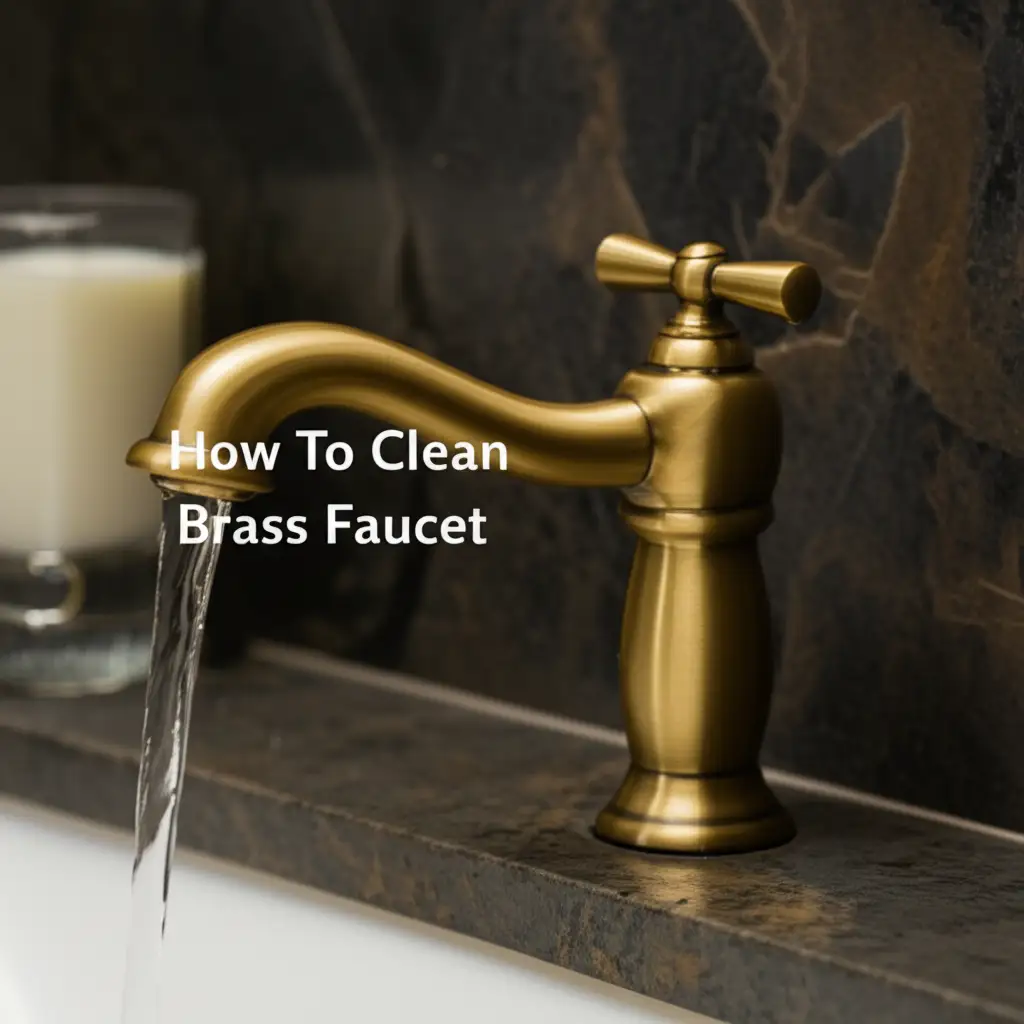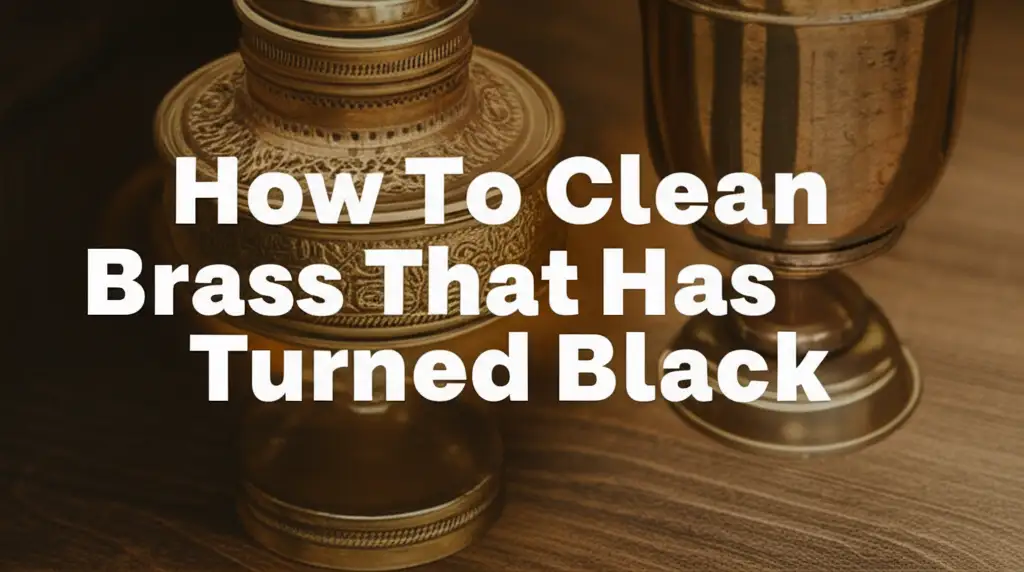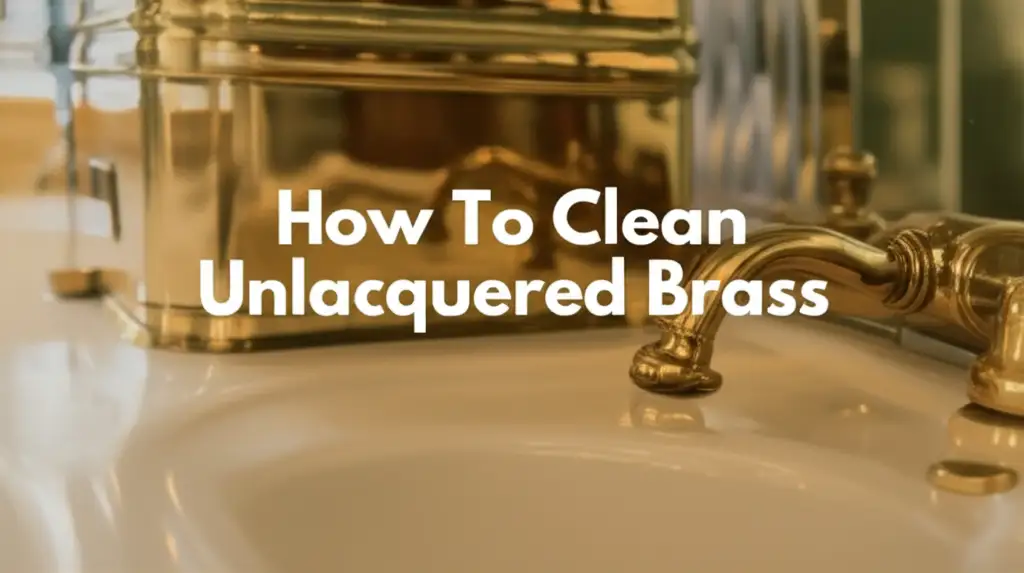· Home Cleaning · 13 min read
How To Clean Brass Faucet

Restore Your Brass Faucet’s Gleam
A shining brass faucet adds warmth and elegance to any kitchen or bathroom. Over time, however, brass can lose its luster. Water spots, mineral deposits, and tarnish begin to appear. Learning how to clean brass faucet fixtures keeps them looking new. This guide will help you bring back that beautiful shine. I will share simple, effective methods for maintaining your brass.
You will learn about identifying your brass type first. This step is important for choosing the correct cleaning method. We will cover gentle, natural solutions for everyday grime. I will also provide stronger techniques for stubborn tarnish. You will discover how to protect your newly cleaned brass. This article will help you restore and preserve your brass faucets.
Takeaway
- Identify brass type (lacquered, unlacquered, antique) before cleaning.
- Use gentle, natural methods like lemon and salt or vinegar for light tarnish.
- Address stubborn tarnish or corrosion with specific techniques or commercial polish.
- Protect cleaned brass with a wax or sealant to slow future tarnishing.
To effectively clean a brass faucet, first identify if it is lacquered or unlacquered. For lacquered brass, use mild soap and water. For unlacquered brass, apply a gentle acidic cleaner like lemon juice and salt or a baking soda paste, then rinse and polish.
Identifying Your Brass Faucet Type for Proper Cleaning
Knowing your brass faucet type is the first step in proper cleaning. Brass comes in different forms. Each type needs a specific approach for cleaning. Using the wrong method can damage the finish.
You can determine your brass type with a simple test. Find a small, hidden area on the faucet. Apply a tiny amount of non-abrasive metal polish or even toothpaste to this spot. Rub gently with a soft cloth.
If the cloth turns black or green, you have unlacquered brass. This means the brass is exposed to air. It will naturally tarnish over time. Unlacquered brass needs regular polishing to maintain its shine. It develops a patina if left uncleaned.
If the cloth remains clean, your faucet is lacquered brass. Lacquered brass has a clear protective coating. This coating prevents tarnishing. It also protects the brass from moisture and air. You must clean lacquered brass very gently. Harsh cleaners can strip this protective layer. This would expose the brass underneath to corrosion.
Some faucets are antique brass or oil-rubbed bronze. These finishes often imitate aged brass. They may not be solid brass at all. Test these areas carefully before cleaning. For more general advice, you can learn how to clean copper and brass effectively.
Gentle Cleaning for Lacquered Brass Faucets
Lacquered brass faucets require gentle care. Their protective coating prevents tarnishing. You must not use harsh chemicals or abrasive scrubbers. These can scratch or strip the lacquer. Damaging the lacquer exposes the brass to air. This will cause unsightly tarnish spots.
I always start with the mildest cleaning solution. Mix a few drops of dish soap with warm water. Dampen a soft cloth with this soapy water. Gently wipe down the entire faucet surface. Make sure to cover all areas. This simple cleaning removes everyday grime and fingerprints. It also keeps the finish looking good.
After wiping, rinse the cloth thoroughly with clean water. Then, wipe the faucet again to remove any soap residue. Soap film can leave streaks or dull the finish. It is important to rinse completely. Finally, dry the faucet immediately with a clean, dry microfiber cloth. This prevents water spots, which can be stubborn on any faucet. If you see spots, you may need to learn how to clean build up on faucet.
For tougher spots, you can make a paste. Mix baking soda with a little water. Apply the paste to the spot. Rub very gently with your finger or a soft cloth. Rinse thoroughly and dry. Remember, gentle is key for lacquered brass to preserve its finish. This method helps maintain the faucet’s original shine.
Restoring Unlacquered Brass: Natural Cleaning Solutions
Unlacquered brass develops a rich patina over time. Some people like this aged look. Others prefer a bright, shiny finish. If you want to restore the shine, natural acidic cleaners work wonders. These cleaners react with the tarnish. They help lift it off the surface.
My favorite natural method uses lemon and salt. Cut a lemon in half. Sprinkle table salt generously onto the cut surface of the lemon. The salt acts as a mild abrasive. It helps remove the tarnish. Rub the lemon directly onto the brass faucet. Focus on tarnished areas. You will see the tarnish start to lift. For an alternative, some people even use how to clean brass with ketchup for similar effects.
Another effective solution is vinegar and salt. Mix equal parts white vinegar and salt to form a paste. Apply this paste to the brass. Let it sit for a few minutes. The acid in the vinegar works on the tarnish. Then, gently scrub with a soft cloth or an old toothbrush. This helps get into crevices.
Baking soda and lemon juice also make a strong cleaning paste. Mix baking soda with enough lemon juice to create a thick paste. Apply this paste to the tarnished brass. Let it sit for 10-15 minutes. Then, gently rub with a soft cloth. Always rinse the faucet thoroughly with warm water after using any of these acidic cleaners. Dry the faucet completely with a clean cloth. This prevents new water spots and tarnishing. These natural solutions are effective and safe for your home.
Tackling Stubborn Tarnish and Corrosion on Brass Faucets
Sometimes brass faucets develop deep tarnish or corrosion. Natural methods may not be enough. This often happens with antique or heavily used fixtures. It is important to address these issues. Neglecting heavy tarnish can lead to permanent damage. This also impacts the faucet’s function.
For severe tarnish, I turn to stronger, but still safe, options. A commercial brass polish is a good choice. Always choose a non-abrasive polish. Read the product instructions carefully before use. Apply a small amount of polish to a soft cloth. Rub it onto the tarnished areas. You will need to apply some elbow grease. The tarnish will transfer to your cloth. Keep turning the cloth to a clean section. This prevents re-depositing the tarnish. If your brass has turned black, you may need a more aggressive approach like techniques for how to clean brass that has turned black.
For very stubborn spots or corrosion, a paste of baking soda and vinegar can be more potent. Mix baking soda with just enough white vinegar to form a thick paste. Apply it directly to the corroded area. Let it sit for 20-30 minutes. The reaction between baking soda and vinegar helps break down the corrosion. Gently scrub with a soft brush or non-scratch pad. Rinse thoroughly with warm water. Dry immediately.
If the corrosion is severe, you might need a specialized cleaner for heavy corrosion. These are usually designed for specific metals. Always test in an inconspicuous area first. Ensure good ventilation when using stronger chemicals. Sometimes, for very old or deeply corroded pieces, professional restoration might be needed. This is especially true if you are dealing with how to clean heavily corroded brass.
Polishing and Protecting Your Brass Faucet’s Shine
Once you have cleaned your brass faucet, you want that shine to last. Polishing and protecting are crucial steps. This slows down future tarnishing. It keeps your faucet looking its best for longer.
After cleaning, I always give the brass a final polish. Use a clean, dry microfiber cloth. Buff the entire surface gently. This brings out the maximum shine. It also removes any remaining residue from cleaning agents. The goal is a streak-free, gleaming finish. This step makes a big difference in the final appearance.
To protect the newly polished brass, I recommend applying a thin layer of wax. Carnauba wax or beeswax are excellent natural options. Apply a very small amount of wax to a soft cloth. Rub it evenly over the brass surface. Let the wax dry to a haze. Then, buff it off with another clean, dry cloth. The wax creates a protective barrier. It slows down the oxidation process. This means your brass will stay shiny for longer. This also applies to how to clean antique brass hardware if you want to maintain its look.
Some people use clear lacquer sprays for protection. This is an option if you want to completely prevent tarnishing. However, it is a more permanent solution. It can be tricky to apply evenly. If the lacquer chips, tarnish can form underneath. This creates a challenging repair. For unlacquered brass, regular cleaning and waxing are usually sufficient. This helps you avoid completely stripping away the patina if that is not your goal, which is useful when considering how to clean brass without removing patina.
Maintaining Your Brass Faucet: Everyday Care Tips
Regular maintenance is key to keeping your brass faucet beautiful. Small, consistent efforts prevent heavy tarnish buildup. This makes future deep cleaning much easier. My routine helps avoid common problems like water spots and soap scum.
First, wipe down your brass faucet regularly. I do this daily or every other day. Use a soft, damp cloth. Dry it immediately with a separate clean, dry cloth. This simple habit removes water droplets. It prevents hard water stains and mineral deposits from forming. Hard water is a major culprit for dulling brass. Daily wiping keeps these issues at bay. This kind of care is beneficial for any fixture, similar to general advice on how to clean sink faucet.
Avoid abrasive cleaners, scourers, or harsh chemicals. These can scratch the finish on lacquered brass. They can also strip protective layers or even etch unlacquered brass. Always check product labels. Look for “safe for brass” or “non-abrasive” claims. Even some general bathroom cleaners are too strong for brass.
Consider the products you use around the faucet. Some soaps or hand lotions can leave residue. Wipe these away promptly. If you notice any specific buildup, address it quickly. For example, if you see black gunk, learn how to clean black gunk from faucet. Small spots are easier to clean than large, set-in stains. A little attention each day goes a long way.
Finally, consider the aerator. Mineral buildup in the aerator can affect water flow. You might need to clean the aerator occasionally. This is often done by soaking it in vinegar. This process helps maintain overall faucet performance. You can even learn how to clean faucet aerator without removing if it’s convenient.
Dealing with Specific Brass Faucet Issues
Brass faucets can encounter unique problems. These require specific cleaning solutions. Understanding how to handle them keeps your faucet pristine. I have dealt with these issues many times.
Hard Water Stains: These appear as white, chalky spots. They are mineral deposits left by evaporating water. For light stains, a vinegar-soaked cloth works well. Wrap the cloth around the faucet. Let it sit for 15-30 minutes. Then, gently scrub with a soft brush. Rinse and dry thoroughly. For stubborn stains, you can make a paste of baking soda and vinegar. Apply it and let it sit longer before scrubbing. This is a common issue, and cleaning hard water buildup is similar to general tips on how to clean faucet head without vinegar.
Green Patina or Verdigris: This green-blue layer forms on brass due to oxidation and moisture. It is a sign of corrosion. Create a paste with equal parts salt, white vinegar, and flour. Apply it to the green areas. Let it sit for several hours or overnight. The flour helps hold the acid in place. Scrub gently with a soft brush. Rinse well and dry completely. This method helps lift the stubborn green layer.
Scratches and Dents: Minor scratches on unlacquered brass can sometimes be buffed out. Use a very fine-grit polishing compound designed for brass. Apply sparingly with a soft cloth. Rub in small circles. This can reduce the appearance of shallow scratches. Deeper scratches or dents usually require professional repair. Polishing compounds can damage lacquered brass. Avoid them on coated surfaces.
Discoloration from Cleaning Products: Sometimes, using the wrong cleaner can cause discoloration. If the brass turns darker or uneven, try a fresh application of a natural acidic cleaner. Lemon and salt or vinegar paste might help. If it is lacquered brass and the lacquer is damaged, repair might be complex. You might need to remove all lacquer and re-lacquer. Or, you can embrace the unlacquered look. Always test new cleaning products in a hidden spot first.
FAQ Section
Can I use vinegar to clean all types of brass faucets?
No, vinegar is acidic and best for unlacquered brass to remove tarnish. It can strip the protective coating on lacquered brass, causing damage. Always identify your brass type first. Use only mild soap and water on lacquered surfaces.
How often should I clean my brass faucet?
For lacquered brass, a quick wipe-down with a damp cloth daily or every other day is ideal. Unlacquered brass can be cleaned every few weeks or months. This depends on how quickly it tarnishes and your desired level of shine.
What causes brass faucets to tarnish?
Brass tarnishes when exposed to air and moisture. This process is called oxidation. Humidity, water spots, and certain chemicals in cleaning products can speed up tarnishing. This results in a dull, sometimes darkened, appearance.
Can I prevent my brass faucet from tarnishing?
You can slow down tarnishing. Regularly wipe your faucet dry after each use. Apply a thin coat of wax or a clear lacquer sealant. This creates a barrier against air and moisture. This method is especially helpful for unlacquered brass.
Is it safe to use abrasive scrubbers on brass faucets?
No, abrasive scrubbers are not safe for brass faucets. They can scratch both lacquered and unlacquered finishes. This creates dull spots or damages the protective coating. Always use soft cloths, sponges, or very soft brushes for cleaning.
What if my brass faucet has a protective coating that is flaking?
If a brass faucet’s lacquer coating is flaking, it needs repair. You can try to remove all existing lacquer using a chemical stripper. Then, polish the brass and re-apply a new lacquer coating. Alternatively, you can leave it unlacquered and maintain it with regular polishing.
Conclusion
Cleaning your brass faucet helps keep its elegant appearance. By identifying your brass type, you ensure the right cleaning approach. Gentle methods work for lacquered brass. Natural acids restore the shine of unlacquered brass. Remember to protect your cleaned faucet with a wax or sealant. This slows down future tarnishing.
Regular maintenance is simple. Wipe your brass faucet dry after each use. Avoid harsh chemicals. This keeps minor issues from becoming major problems. With these tips, you can maintain your beautiful brass fixtures for years. Your how to clean brass faucet knowledge will ensure they always shine. Keep your home fixtures sparkling with these easy steps.
- Brass Cleaning
- Faucet Care
- Tarnish Removal
- Home Maintenance




